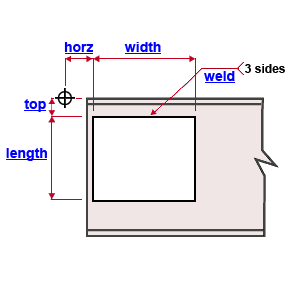"  Beam Web Doubler " connection design locks
Beam Web Doubler " connection design locks
| Beam web doublers may be designed when clip angles or bent plates attach to the supported beam's web. They may be needed to compensate for a cope to the beam's web. |
- For doublers on ' Both sides ' of the web, the same locks control both doublers.
- When " Plate location " is set to ' Neither side ', the doubler is removed.
|
||||
"  |
|
|||
|
||||
Connection Guide: click here or here .
Welded verses bolted doublers: For clip angles or bent plates that weld to the supported beam, connection design welds the beam web doublers. For clip angles or bent plates that bolt to the supported beam, connection design bolts the beam web doublers.
User Defined Connections: Settings that are locked (
) in a user defined connection file will automatically be locked on a member edit window for which that file is the " Input connection type ." You can, if you so choose, manually lock additional settings on the member edit window, and your changes will be retained, through multiple processes, so long as you do not change to a different connection then switch back to the original user defined connection.
Beam Edit: To change a setting, first set it to locked (
). Related settings that are unlocked (
) may be updated, and the "
Left/Right end limit state " calculations will be updated. Settings that are locked (
) will not be changed by connection design , even if doing so might prevent a connection failure.
Connection design locks (also see the drawing ) :
| Locks not dimensioned or called out on the drawing are marked ( not depicted ). |
![]() Beam Web Doubler
Beam Web Doubler
For a clip angle or bent plate connection
Horizontal to plate ( horz ): The distance (parallel with the work line of the beam) from the work point of the beam to the edge of the web doubler plate that is closest to that work point (see example ). This distance is horizontal only if the beam is horizontal.
Top of plate ( top ): The distance (perpendicular to the work line of the beam) from the top flange of the beam to the top edge of the web doubler plate (see example ). For a non-sloping beam, this distance is vertical.
Plate length ( length ): The distance (parallel with the depth of the beam) between the two edges of the web doubler plate that are parallel with the work line of the beam (see example ). For a non-sloping beam, this distance is vertical. For a sloping beam, this distance is perpendicular to the work line of the beam (parallel with the depth of the beam).
Plate width ( width ): The distance (parallel with the work line of the beam) between the edges of the beam web doubler plate that are perpendicular to the work line of the beam (see example ). For a non-sloping beam, this distance is horizontal.
Plate thickness ( not depicted ): The " Material thickness " of the web doubler plate.
Plate location ( not depicted ): Neither side or Near side or Far side or Both sides . ' Neither side ' causes no web doubler plate to be designed. ' Near side ' designates that a doubler plate be designed on the near side web of the beam. ' Far side ' designates that a doubler plate be designed on the far side web of the beam. ' Both ' designates that a doubler plate be designed on both webs of the beam.
Weld size ( weld ): The weld size used to shop weld the doubler plate to the web of the beam. This applies to a clip angle whose " Attachment to supported " is ' Welded '. When a clip angle or bent plate bolts to the beam web, the doubler plate also bolts to the beam web.







